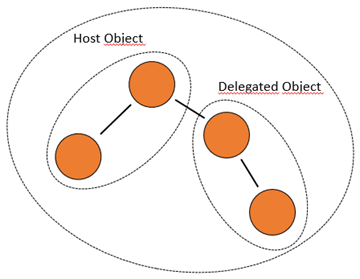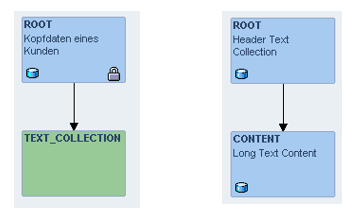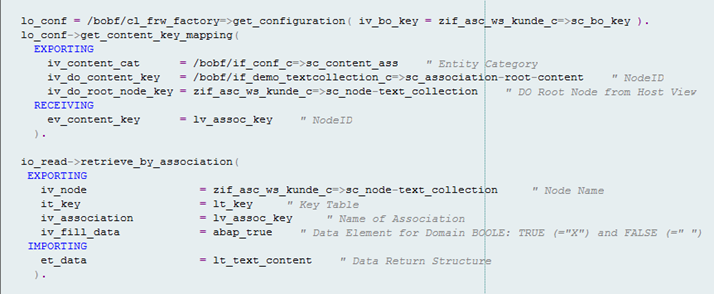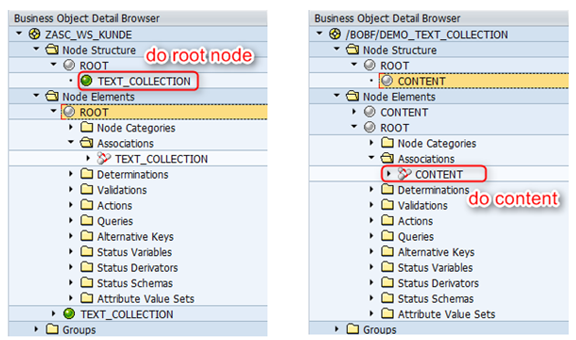
- SAP Community
- Groups
- Interest Groups
- Application Development
- Blog Posts
- Accessing a delegated object in BOPF
- Subscribe to RSS Feed
- Mark as New
- Mark as Read
- Bookmark
- Subscribe
- Printer Friendly Page
- Report Inappropriate Content
A Delegated Object (DO) in BOPF is an elegant way of including identical functionality in multiple business objects, without having to carry out redundant modeling and development of the functionality. Accessing the contents of a DO using ABAP code is however not so trivial. Short ABAP dumps such as /BOBF/CX_FRW_FATAL result, if the seemingly most obvious approach is used for access. In this article, I would like to explain how access to Dos can be achieved with the help of a simple scenario.
Excursus: The delegation concept in BOPF
In BOPF, the concept of delegation refers to encapsulating parts of the model and a subset of functionality into a separate business object known as a delegated object. This business object can then be integrated into numerous other business objects.
To achieve this, BOPF follows a "Black Box" approach. This means that at design time the "host" business object is unaware of the structure of the delegated object. This structure is also not displayed in the modeling environment. The components of the delegated object are incorporated into the "host" business object only at runtime, and both business objects are then merged together into one business object.
A few delegated objects are delivered together with BOPF and can directly be integrated and used in own business objects. Examples include the Address, Text collection, Attachment folder, Business partner and Change document business objects.
Example scenario: The business object
To demonstrate how to use a delegated object, the following business object will be used:
This business object is a simple representation of a customer and consists only of a single root node. Below the root node the delegated object, Text collection (found on the right side) has been incorporated. The objective is to read some data from the delegated object and write it into transient fields of the root node of the customer business object, with the help of a determination.
Solution: Accessing the delegated object
A delegated object is just another business object and many BOPF developers know that cross-BO access (BO A wants to access data from BO B) can only be achieved using the Service Manager. Consequently, a common approach will be to first of all create the Service Manager for the delegated object. However, the framework doesn't permit this instantiation for good reason and will result in a dump at run time. At runtime, the contents of the delegated object are fully integrated into the structure of the "host" business object and consequently access to the content takes place through the Service Manager of the "host" business object. Also, access using io_modify and io_read of the "host" business object is possible. An example of such access is depicted in the following code snippet.
Even with this approach, the application will abort at runtime with a dump. At runtime, new nodes, associations, etc. are generated in the "host" business object based on the delegated objects. These elements have a different technical key as specified in the constants interface of the delegated object. To solve this dilemma, a key mapping must be carried out. This can be seen in the code snippet below.
First of all, the configuration object of the "host" business object is obtained. The configuration object provides a method for the context key mapping. For the method, a content category is specified, i.e. if it is desired to convert the technical key of a node, association or action. Furthermore, the key of the model element to be converted and the root node of the delegated object are specified. See the following screenshot for an illustration.
If this step is taken into consideration, access to the content of a delegated object from the "host" business object is easily possible. When working extensively with delegated objects and in cases where frequent access to different content is required, it is recommended to write generic helper classes which take care of such conversions.
In case of any questions or comments to delegated objects based on your experiences, we will like to hear about them. Also, if you solved this problem using another approach or if this article helped you, we will be pleased to hear about it.
This article is a translated version of the article Zugriff auf ein Delegated Object im BOPF (in German). You can also find other related articles to BOPF and FBI (in German) on our blog Erlebe Software - Individuelle SAP Software.
- SAP Managed Tags:
- ABAP Development
You must be a registered user to add a comment. If you've already registered, sign in. Otherwise, register and sign in.
-
A Dynamic Memory Allocation Tool
1 -
ABAP
8 -
abap cds
1 -
ABAP CDS Views
14 -
ABAP class
1 -
ABAP Cloud
1 -
ABAP Development
4 -
ABAP in Eclipse
1 -
ABAP Keyword Documentation
2 -
ABAP OOABAP
2 -
ABAP Programming
1 -
abap technical
1 -
ABAP test cockpit
7 -
ABAP test cokpit
1 -
ADT
1 -
Advanced Event Mesh
1 -
AEM
1 -
AI
1 -
API and Integration
1 -
APIs
8 -
APIs ABAP
1 -
App Dev and Integration
1 -
Application Development
2 -
application job
1 -
archivelinks
1 -
Automation
4 -
BTP
1 -
CAP
1 -
CAPM
1 -
Career Development
3 -
CL_GUI_FRONTEND_SERVICES
1 -
CL_SALV_TABLE
1 -
Cloud Extensibility
8 -
Cloud Native
7 -
Cloud Platform Integration
1 -
CloudEvents
2 -
CMIS
1 -
Connection
1 -
container
1 -
Debugging
2 -
Developer extensibility
1 -
Developing at Scale
4 -
DMS
1 -
dynamic logpoints
1 -
Eclipse ADT ABAP Development Tools
1 -
EDA
1 -
Event Mesh
1 -
Expert
1 -
Field Symbols in ABAP
1 -
Fiori
1 -
Fiori App Extension
1 -
Forms & Templates
1 -
General
1 -
Getting Started
1 -
IBM watsonx
1 -
Integration & Connectivity
10 -
Introduction
1 -
JavaScripts used by Adobe Forms
1 -
joule
1 -
NodeJS
1 -
ODATA
3 -
OOABAP
3 -
Outbound queue
1 -
Product Updates
1 -
Programming Models
13 -
Restful webservices Using POST MAN
1 -
RFC
1 -
RFFOEDI1
1 -
SAP BAS
1 -
SAP BTP
1 -
SAP Build
1 -
SAP Build apps
1 -
SAP Build CodeJam
1 -
SAP CodeTalk
1 -
SAP Odata
1 -
SAP UI5
1 -
SAP UI5 Custom Library
1 -
SAPEnhancements
1 -
SapMachine
1 -
security
3 -
text editor
1 -
Tools
17 -
User Experience
5
| User | Count |
|---|---|
| 4 | |
| 3 | |
| 2 | |
| 2 | |
| 2 | |
| 2 | |
| 1 | |
| 1 | |
| 1 |




